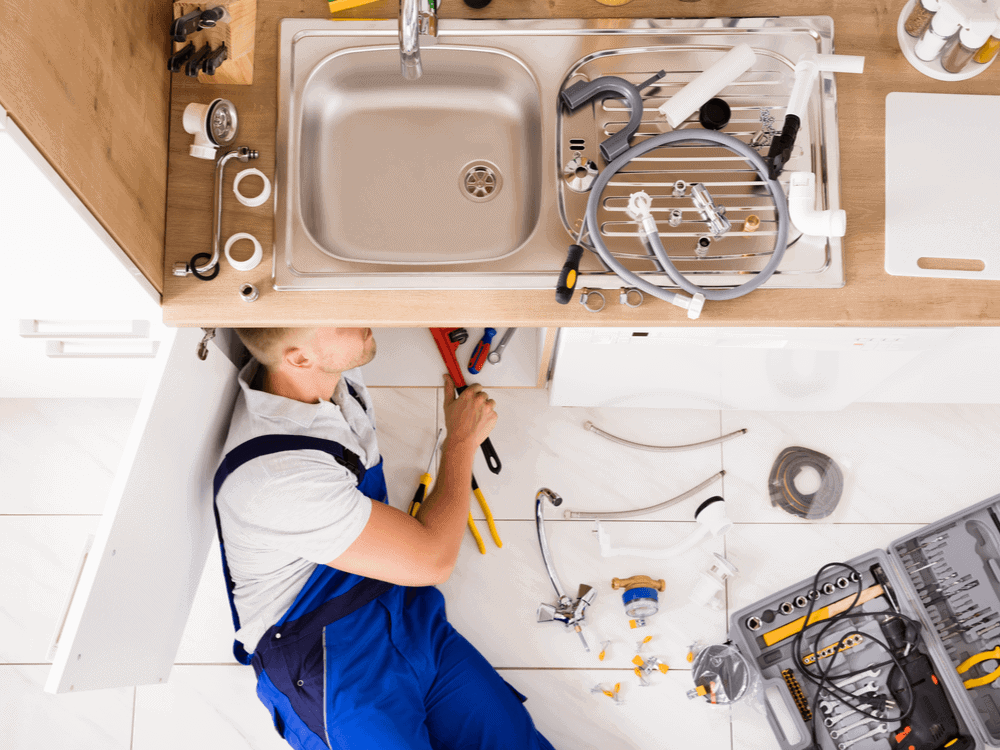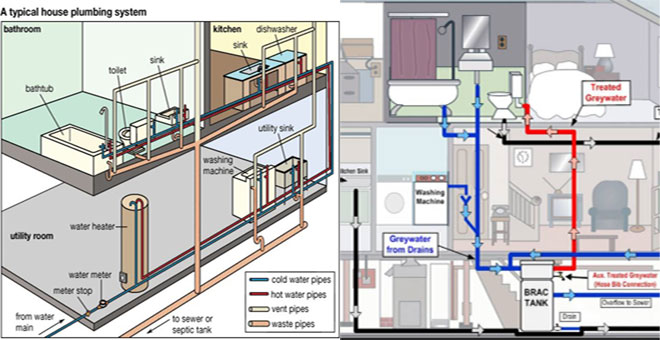Understanding The Layout of Your Property's Plumbing System
Understanding The Layout of Your Property's Plumbing System
Blog Article
What're your ideas on Exploring Your Homes Plumbing Anatomy?

Understanding how your home's plumbing system works is essential for every homeowner. From delivering clean water for drinking, food preparation, and bathing to safely removing wastewater, a well-maintained plumbing system is essential for your family members's wellness and convenience. In this detailed guide, we'll explore the complex network that comprises your home's plumbing and offer pointers on maintenance, upgrades, and handling typical issues.
Intro
Your home's pipes system is more than simply a network of pipelines; it's a complicated system that ensures you have accessibility to tidy water and efficient wastewater elimination. Recognizing its components and just how they work together can assist you stop costly repair work and make sure every little thing runs efficiently.
Standard Parts of a Plumbing System
Pipes and Tubes
At the heart of your plumbing system are the pipelines and tubing that lug water throughout your home. These can be constructed from different materials such as copper, PVC, or PEX, each with its benefits in terms of toughness and cost-effectiveness.
Fixtures: Sinks, Toilets, Showers, and so on.
Components like sinks, toilets, showers, and bathtubs are where water is made use of in your house. Understanding just how these fixtures link to the plumbing system helps in detecting issues and planning upgrades.
Shutoffs and Shut-off Factors
Valves control the circulation of water in your plumbing system. Shut-off valves are critical throughout emergency situations or when you need to make repairs, permitting you to isolate parts of the system without interfering with water circulation to the whole house.
Water System System
Key Water Line
The main water line links your home to the local water or a personal well. It's where water enters your home and is dispersed to different components.
Water Meter and Pressure Regulatory Authority
The water meter actions your water usage, while a stress regulatory authority makes certain that water flows at a risk-free stress throughout your home's pipes system, preventing damages to pipelines and components.
Cold Water vs. Hot Water Lines
Comprehending the difference between cold water lines, which supply water directly from the major, and hot water lines, which lug heated water from the water heater, assists in repairing and planning for upgrades.
Drain System
Drain Pipeline and Traps
Drain pipelines lug wastewater away from sinks, showers, and toilets to the drain or septic system. Traps stop sewage system gases from entering your home and also trap debris that might create clogs.
Ventilation Pipelines
Air flow pipelines permit air into the drainage system, protecting against suction that can slow drainage and trigger traps to empty. Appropriate air flow is important for preserving the stability of your pipes system.
Relevance of Correct Water Drainage
Making sure correct water drainage protects against back-ups and water damages. Routinely cleaning drains pipes and preserving traps can stop expensive repair services and prolong the life of your pipes system.
Water Heating Unit
Types of Hot Water Heater
Hot water heater can be tankless or conventional tank-style. Tankless heaters heat water on demand, while containers keep heated water for instant use.
Exactly How Water Heaters Connect to the Plumbing System
Comprehending exactly how water heaters connect to both the cold water supply and hot water circulation lines assists in diagnosing issues like not enough warm water or leakages.
Maintenance Tips for Water Heaters
Routinely flushing your water heater to remove debris, examining the temperature settings, and inspecting for leakages can expand its life-span and enhance power effectiveness.
Typical Plumbing Concerns
Leaks and Their Causes
Leakages can happen due to maturing pipelines, loose fittings, or high water stress. Resolving leakages quickly protects against water damages and mold growth.
Obstructions and Obstructions
Clogs in drains pipes and bathrooms are frequently caused by purging non-flushable products or a buildup of oil and hair. Utilizing drainpipe screens and being mindful of what drops your drains pipes can prevent obstructions.
Indications of Pipes Issues to Expect
Low tide pressure, slow-moving drains, foul odors, or abnormally high water expenses are indicators of prospective plumbing troubles that must be resolved immediately.
Plumbing Upkeep Tips
Regular Assessments and Checks
Schedule yearly plumbing assessments to capture problems early. Look for indicators of leakages, rust, or mineral build-up in faucets and showerheads.
Do It Yourself Maintenance Tasks
Easy tasks like cleansing faucet aerators, looking for commode leaks utilizing color tablets, or shielding exposed pipelines in cool climates can stop significant pipes concerns.
When to Call a Professional Plumbing Professional
Know when a plumbing problem calls for professional expertise. Attempting complicated fixings without proper understanding can bring about even more damages and greater repair expenses.
Updating Your Pipes System
Factors for Upgrading
Upgrading to water-efficient components or changing old pipelines can improve water quality, decrease water expenses, and raise the worth of your home.
Modern Plumbing Technologies and Their Advantages
Discover modern technologies like smart leak detectors, water-saving toilets, and energy-efficient hot water heater that can conserve cash and reduce environmental impact.
Cost Considerations and ROI
Compute the ahead of time costs versus long-term savings when considering plumbing upgrades. Many upgrades spend for themselves via lowered energy costs and less fixings.
Ecological Impact and Conservation
Water-Saving Fixtures and Appliances
Installing low-flow taps, showerheads, and bathrooms can substantially lower water usage without sacrificing efficiency.
Tips for Lowering Water Use
Straightforward behaviors like fixing leakages promptly, taking much shorter showers, and running complete lots of washing and dishes can save water and lower your utility costs.
Eco-Friendly Pipes Options
Think about sustainable plumbing products like bamboo for floor covering, which is durable and eco-friendly, or recycled glass for kitchen counters.
Emergency situation Preparedness
Steps to Take Throughout a Pipes Emergency situation
Know where your shut-off shutoffs are located and how to turn off the water in case of a ruptured pipe or major leak.
Significance of Having Emergency Get In Touches With Useful
Keep contact information for neighborhood plumbing professionals or emergency services conveniently available for fast feedback during a pipes dilemma.
DIY Emergency Situation Fixes (When Suitable).
Short-term solutions like making use of air duct tape to patch a dripping pipe or positioning a bucket under a trickling tap can reduce damages up until a specialist plumbing technician arrives.
Verdict.
Recognizing the anatomy of your home's pipes system empowers you to keep it efficiently, conserving time and money on fixings. By adhering to routine maintenance regimens and remaining informed concerning modern plumbing modern technologies, you can guarantee your pipes system runs efficiently for years ahead.
HOW YOUR PLUMBING SYSTEM WORKS
Which Pipes Do What?
Blue lines = fresh water supply entering the building
Red lines = hot water supply entering the building
Grey lines = pipes carrying waste away from the building and venting pipes carrying gases away from the building (through the roof)
YOUR MAIN PLUMBING SYSTEMS
There are two main plumbing systems that support your home s basic plumbing needs one that brings clean water into your home, and one that sends dirty water away from your home. Connected to the toilet, bath, shower, and other faucets in your home, these two systems keep your water flowing in the right directions.
ACCESSING FRESH WATER
Fresh and clean water is brought into your home through the main water supply line . Filtered through one pipe, this water is pressured to flow into the various fixtures in your home at any given time.
This water can be sourced from a well located on your property, a pond or river (mostly cottages), or, as in most cases, from the city s municipal water treatment centre. However, it is important to note that water that is untreated, such as the water siphoned from ponds or rivers, may not be safe to drink. Personal water supplies always need to be treated for hardness and contaminants before consumed.
MUNICIPAL WATER SUPPLIES
Improve taste and odour
Remove sediment
Eliminate hardness
Reduce chlorine
COLD WATER SUPPLY VS. HOT WATER SUPPLY
Cold water flows into your home or building through the service line, which then distributes hot or cold water to your fixtures. This line is most commonly run through a central column that runs floor to floor. Hot water runs in short and straight pipes as the longer the pipeline, the more heat that will be lost in the transfer. Having shorter pipes also allows residents to access hot water more quickly.
WASTE WATER SYSTEM
Your wastewater system is divided into two parts pipes that send wastewater away from your home and venting pipes that send sewer gas away from your home. Sewage water travels through pipes that flush the water and waste towards local sewers that are operated and managed by your city or town. Most sewer systems rely on gravity to move the wastewater to where it needs to go.
The further away from your toilet or sink, the larger wastewater pipes become. This allows for waste to be disposed of from various parts of your home or business at once without pipe blockages. The angle and flow of these pipes are also essential for keeping your waste pipes clear of build up.
https://harrisplumbing.ca/how-your-home-plumbing-system-works/

HOW YOUR PLUMBING SYSTEM WORKS
Which Pipes Do What?
YOUR MAIN PLUMBING SYSTEMS
There are two main plumbing systems that support your home s basic plumbing needs one that brings clean water into your home, and one that sends dirty water away from your home. Connected to the toilet, bath, shower, and other faucets in your home, these two systems keep your water flowing in the right directions.
ACCESSING FRESH WATER
Fresh and clean water is brought into your home through the main water supply line . Filtered through one pipe, this water is pressured to flow into the various fixtures in your home at any given time.
This water can be sourced from a well located on your property, a pond or river (mostly cottages), or, as in most cases, from the city s municipal water treatment centre. However, it is important to note that water that is untreated, such as the water siphoned from ponds or rivers, may not be safe to drink. Personal water supplies always need to be treated for hardness and contaminants before consumed.
MUNICIPAL WATER SUPPLIES
COLD WATER SUPPLY VS. HOT WATER SUPPLY
Cold water flows into your home or building through the service line, which then distributes hot or cold water to your fixtures. This line is most commonly run through a central column that runs floor to floor. Hot water runs in short and straight pipes as the longer the pipeline, the more heat that will be lost in the transfer. Having shorter pipes also allows residents to access hot water more quickly.
WASTE WATER SYSTEM
Your wastewater system is divided into two parts pipes that send wastewater away from your home and venting pipes that send sewer gas away from your home. Sewage water travels through pipes that flush the water and waste towards local sewers that are operated and managed by your city or town. Most sewer systems rely on gravity to move the wastewater to where it needs to go.
The further away from your toilet or sink, the larger wastewater pipes become. This allows for waste to be disposed of from various parts of your home or business at once without pipe blockages. The angle and flow of these pipes are also essential for keeping your waste pipes clear of build up.
https://harrisplumbing.ca/how-your-home-plumbing-system-works/
We hope you enjoyed reading our post about The Inner Workings of Your Home's Plumbing. Many thanks for taking time to read our blog post. Loved our posting? Please share it. Help other people locate it. Thanks for taking the time to read it.
Schedule Service Report this page